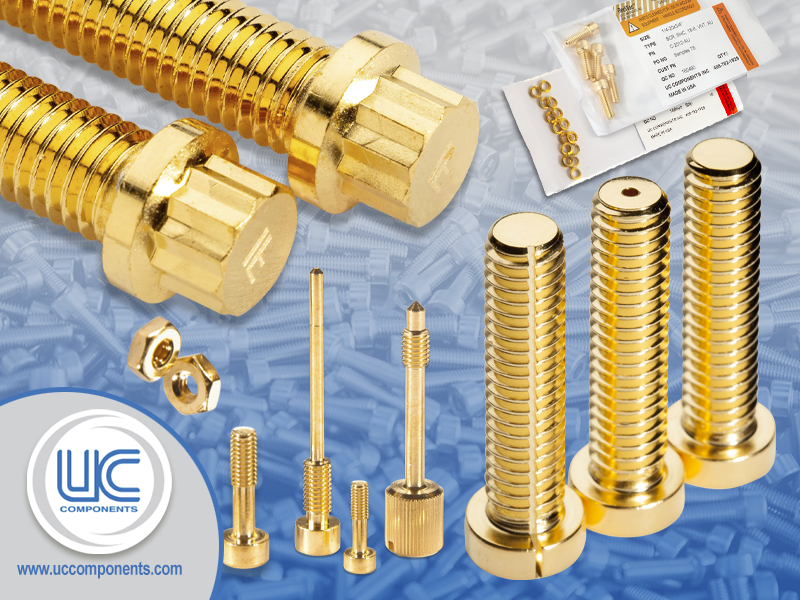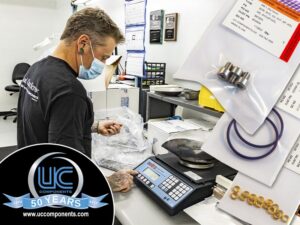Fasteners installed in any piece of equipment need to be long-lasting and able to withstand repeated use (when appropriate). Coatings and platings help prevent or solve a variety of issues such as prevention of fastener galling (stainless to stainless cold welding), improve corrosion resistance, improved surface finish, cosmetic enhancement, and more.
Gold, specifically, is typically selected for its aesthetic, and beautiful, appeal but it also offers quite a few attractive properties such as high electrical conductivity, it can shield parts from damage from extreme heat, it is very durable, and offers good resistance to corrosion, wear, and tarnish.
The main industry to utilize gold is the electronics industry due to the alloy’s electrical conductivity and durability properties. Components such as connectors, contacts, switches, and other parts are often plated with gold. Gold is also used extensively in the medical and dental fields as gold is one of the most biocompatible metals on the market today; meaning it will not create adverse reactions when in contact with skin, organs, or other tissue.
So why exactly is gold selected for medical devices?
| Biocompatible | Will not create adverse reactions when in contact with skin, organs, or other tissue. Reduces risks of post-operative infections after insertion of implants, pacemakers, stents, and more. |
| Density | High density makes it opaque to x-rays. |
| Electrical Conductivity | Exceptional long-term conductivity which makes it well suited for electrical devices or electronic parts/components |
| Excellent Corrosion Resistance | Gold will oxidize in air though it is very slow to do so and color change is minimal. It is highly resistant to rust and most corrosive materials and acids will not affect the metal. Can stay inside of a body with no concern of corrosion affecting the device’s long-term safety or performance. |
| Malleable | It is soft which provides flexibility for manufacturing complex and high-precision products. The metal will conform relatively easily to the configuration of the device which results in improved quality and product performance. |
| Visibility | The metal is quite bright which helps make it more visible when inserted inside of a body. This allows devices to be places with a higher level of accuracy and makes it easier find it later (if necessary) to assess the performance of the device. |
| Weldability (or Solderability) | Helps provide a secure connection when welding or soldering dissimilar metals together during the manufacture of a device or implant. |
Where is gold used in the medical and dental fields?
There are numerous medical and dental applications for gold-plating. What types of parts or components are plated with gold? Items such as (but not limited to):
- Casing for batteries
- Dental devices (brackets, arch wires, false teeth, fillings, crowns, caps, and more)
- Fasteners
- Housings
- Implants
- Metallization of plastics
- Pacemakers
- Scopes
- Stents
- And more
How is a device or component plated or coated with gold?
You cannot simply use pure gold, however, to make a part or component. It is way too soft and way too expensive – the piece is made out of another material (for example, an alloy of stainless steel) and then coated or plated with gold. There are three main ways to perform the plating. Those processes are PVD gold sputtering coating, gold filling, and gold plating. What is the difference?
| PVD Gold Sputtering Coating | Gold Filling | Gold Plating |
| Applied by high energy plasma on a single atom layer with extreme purity. | This is mechanical bonding of gold to the underlying metal utilizing high pressure and temperature. | This is typically done by electroplating application of gold applied in a chemical bath via electrical charge. |
| This process produces the hardest and strongest bond. | This process is more expensive since you need a greater quantity of gold for the coating. | This process is less expensive and produces a relatively soft coating. |
While gold is not the least expensive material to work with (particularly when compared to less expensive alloys such as copper, nickel, or tin) it is the preferred plating option for many medical and dental devices. Gold’s exceptional qualities make it a better choice overall and can actually be cost-effective in the long run when you factor in the return for the manufacturer as well as the return for the end user or recipient.
How can fasteners from UC Components, Inc. help you?
UC Components, Inc. has been the world leader in high vacuum hardware since 1974. We offer a range of finishes for our RediVac® line of fasteners, washers, and hex nuts. These coatings and platings are designed to prevent galling and/or improve the corrosion resistance of the treated component. All our coatings and platings are vacuum compatible, dependent on your specific process chemistry. The right coating or plating for your HV or UHV application is best defined by your process engineer.
View our parts catalog online to find the components you need, request a quote, or contact us for more assistance or additional information. If you do not see the items that you need listed in our standard products, please give us a call! We may not stock it but we are happy to acquire and manufacture just about any fastener or O-ring that you need.



